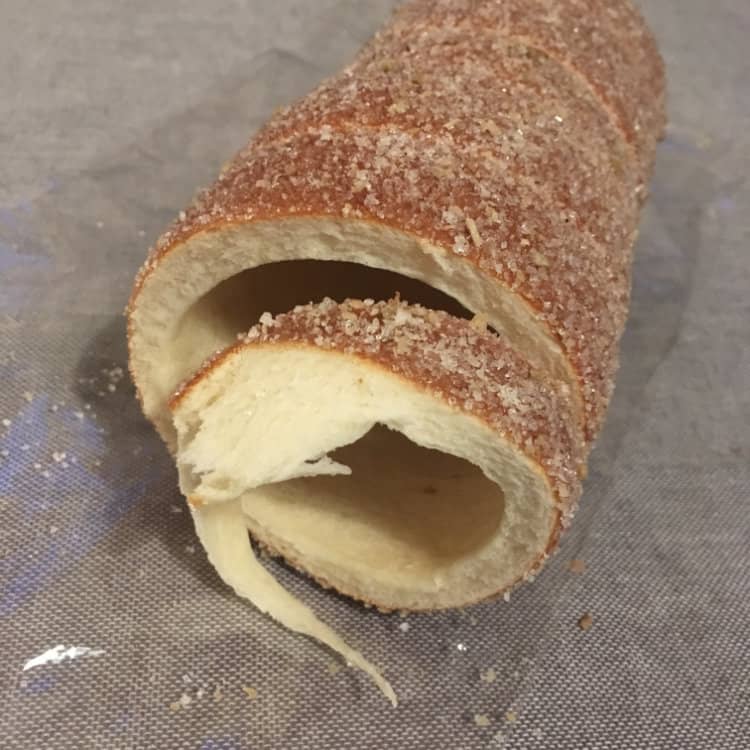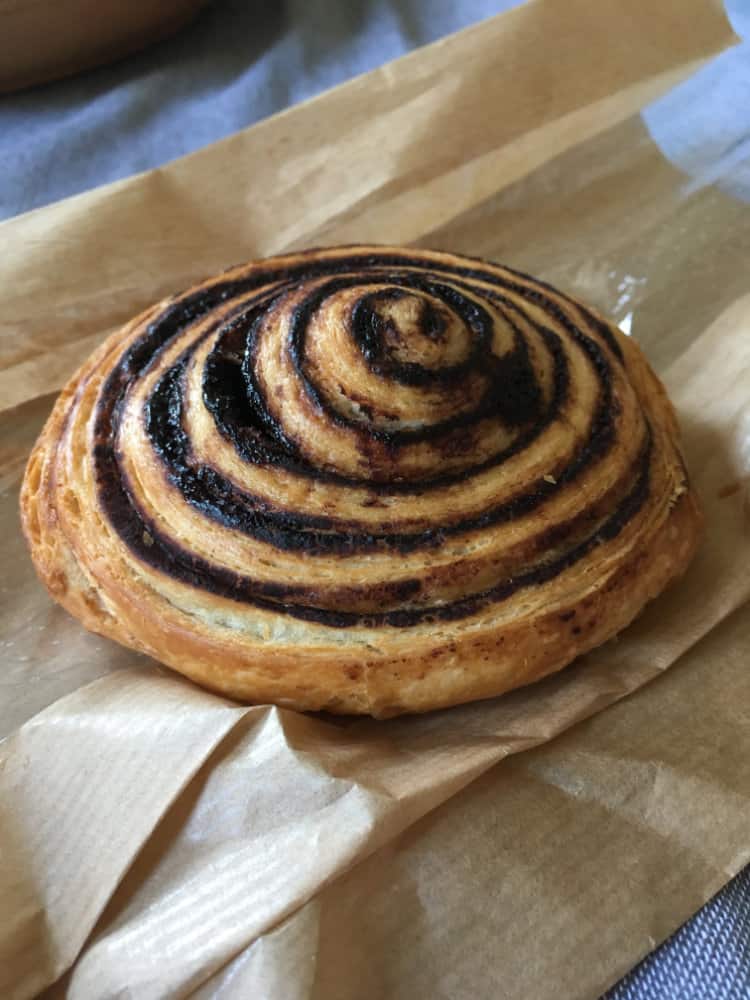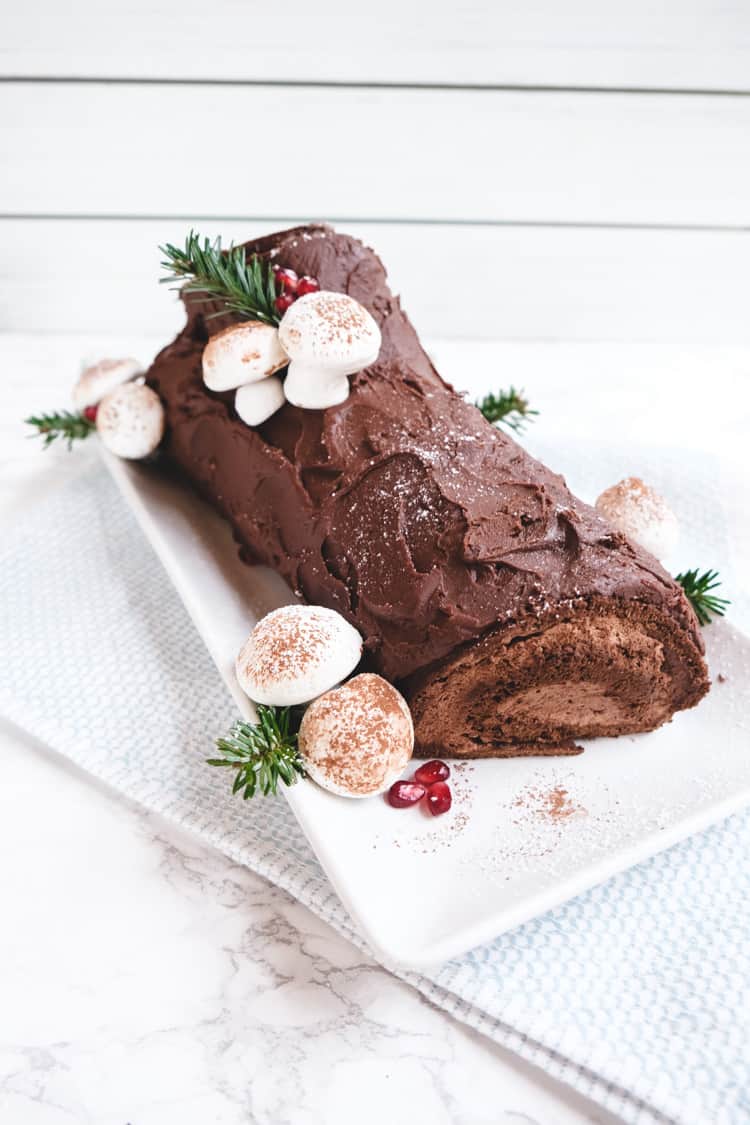10 Must-Try Hungarian Desserts & Sweet Treats
This article may contain affiliate links. See our disclosure link for more information.
The land of plums, poppy seed, and cottage cheese, of simple but heart-warming treats, and of multilayered, creamy and luxurious cakes: this is Hungary! With all this variety and creativity, it is certainly hard to choose which Hungarian desserts to try.
Nonetheless, after living in Budapest for a few years, I am happy to share the 10 must-try desserts and sweets in Hungary, which will certainly leave you happy and satisfied.
Contents
10 Must-Try Hungarian Desserts and Sweets
1. Palacsinta

Palacsinta is the Hungarian version of crepes: a batter of flour, milk and eggs is cooked on a hot surface, and eaten with a sweet filling (sometimes savoury). Even though crepes are traditionally French and very common all around the world, Hungarians serve them with their own twist.
First of all, the presentation: Hungarian palacsinta are rolled, not folded, and usually they are sprinkled with powdered sugar. Secondly, the filling: besides the traditional jams/confiture or Nutella, Hungarians love palacsinta filled with turo cheese, a soft, dry cottage cheese with a delicate taste between sweet and acidic. Other traditional fillings are cinnamon, sour-cherry, and poppyseed. My favourite, however, is homemade apricot jam.
One specific type of palacsinta is Gundel palacsinta, famously served by the legendary Gundel family: filled with rum-walnut cream with chocolate sauce dripped on top. At Gundel Restaurant in Budapest, they will flambé it in front of you!
Don’t be tricked by Hortobagyi palacsinta: it’s filled with minced meat and vegetables, and covered in a rich paprika sauce. Still delicious, but definitely not a dessert!
Palacsinta are very easy to find anywhere in Hungary. When sold at festivals or parades, keep in mind that a Hungarian grandmother probably woke up at 5 in the morning to prepare in advance hundreds of empty palacsinta, to be warmed up and filled during the day. Enjoy the grandma love!
2. Kürtőskalács

Also popular in Czech Republic and Romania, it is translated as “chimney cake”. It literally looks like a chimney: a soft dough is wrapped around a wooden cylinder and then slowly baked over embers, producing an empty cylinder approx 15-20 cm long, soft on the inside, and slightly sticky and crunchy on the outside. It is usually sprinkled with cocoa or chopped hazelnuts, but cinnamon is a more traditionally Hungarian topping.
You will not find this in restaurants or cafés: kürtőskalács is sold in kiosks on the street, or at festivals. It’s large enough to serve as a snack to 2-3 people! Watch out, it’s supposed to be cheap: anything more than 600 HUF (approx 2 EUR) and it’s a robbery.
Recently, a “filled” version is becoming more popular: a portion of the cylinder is filled with ice-cream or whipped cream. A delicious caloric bomb that can replace a full meal!
3. Túrógombóc

Túrógombóc can be translated into cottage cheese dumplings: they are round dumplings of turo cottage cheese, cooked in hot water, coated in toasted breadcrumbs and served still warm and soft. Flavours like vanilla or lemon zest can be added in the turo cheese mix, together with egg white and egg yolk to make it light and fluffy. It does not contain sugar, so just a sprinkle of sugar is added on top, together with a fresh fruits and a generous spoonful of sour cream, another ingredient very dear to Hungarians.
You can enjoy túrógombóc in restaurants; it may come in small and large size, and sometimes covered in other types of sour cream-based toppings. It’s my mom’s favourite Hungarian dessert: we’re always on the look-out for new restaurants that serve it. Perfect for people with a not-too-sweet tooth.
Click here to check out the 10 must-try desserts and sweets in Germany!
4. Rétes

Did you know that most probably strudel is a great-great-grandchild of Turkish baklava? It seems that this dessert travelled through the Ottoman empire, and reached the Balkans and Hungary in the 16th century. Later on, in the 18th-19th century, the current stuffed version was created in the Austro-Hungarian empire.
Rétes, the Hungarian version of strudel, is not quite like Austrian strudel. The dough is much thinner and flakier; the filling is more creamy, compared to the cubes and slices of apples typical of Austria. Leave the apples and try a traditional filling: plums, sour cherries, poppy seed (make sure you have your toothbrush/a mirror with you!), or cottage cheese “turo”, either pure, or mixed with fruit jams/confiture.
Restaurants also come up with creative versions of rétes with a savoury filling, such as chicken, salmon, or vegetables. A perfect, complete meal.
5. Túró Rudi

For those of you on a budget, and for those of you who love foreign supermarkets: get a túró rudi from the fridge section! This is the flavour that all Hungarians identify with their childhood and carry on through their lives: fresh túró cheese covered in crunchy, bitter chocolate. Yes, Hungarians are really obsessed with turo cottage cheese!
While perhaps not the most delicious and memorable Hungarian dessert, it carries a strong cultural value. Many brands have tried to copy the original, Pöttyös (literally “polka dotted”), but nobody has ever achieved it. It’s the perfect snack for children, it’s the sweet bite that office workers need after lunch; it’s so beloved, that even Hungarian delis get it shipped abroad, to satisfy Hungarian expats around the world.
6. Kakaós csiga

A cheap bite for breakfast is the Chocolate Snail, “Kakaós csiga”. Different legends tell about the birth of this typical Hungarian pastry: it was created using leftovers from other pastries, sprinkled with cocoa powder and rolled up; it was invented by a baker for his own birthday party, which was such a success that he kept baking it for his satisfied customers. Undoubtedly, nowadays it is one of the most beloved Hungarian bakery products.
Look for it in bakeries on the street, in the bakery section of supermarkets, or in the underground bakeries in the metro stations in Budapest. A good Kakaós csiga should be crispy on the edge, but soft in the middle, and never dry: this is how you know that a healthy amount of butter was added to the dough of flour, eggs, milk, sugar and yeast.
I love to start eating it from the outer end, slowly making my way to the super-chocolatey centre. It’s even better with a cappuccino or a simple glass of milk.
Click here to see the 10 must-try desserts and sweets in Colombia!
7. Dobos torta

Undoubtedly the most famous Hungarian cake, Dobos torta (“torta” means cake in Hungarian) was invented in 1885 by chef and confectioner József C. Dobos.
Like most iconic Hungarian cakes, Dobos cake is made of layers: 6 layers of thin sponge cakes alternated with chocolate butter cream. Thick, hard caramel slices cover the top, and ground walnuts coat the sides, in order to prevent it from drying: a clever way to make the cake last longer on shelves, back when refrigerating techniques were limited.
As you sit down in an elegant café with a cup of tea and your fabulous Dobos slice in front of you, take a few seconds to appreciate the softness of the filling. It’s not just melted butter with chocolate: eggs beaten over boiling water are also added, to give extra fluffiness to the chocolate butter cream.
8. Somlói galuska

Another dessert created in the halls of the famous Gundel restaurant in Budapest, Somlói galuska is a favourite of Hungarians. Do not mistake it as a traditional dessert of the region of Somló: it’s actually a typo of Somlyó, the creator’s hometown.
Even though “galuska” can be translated into “dumplings”, this is a misleading word: this dessert is composed of several layers of sponge cake of different tastes, scooped into 3 balls, and served with whipped cream.
There are so many ways of serving it: in glass bowls, on a dish, in the shape of a slice of cake, or arranged in artistic ways in Michelin star restaurants. However, the layers of sponge cake must be plain, chocolate, and walnut; they are soaked in rum, to make them even softer; and they are alternated by custard cream, sometimes with raisins. Besides whipped cream, they are usually topped with chocolate syrup, and almonds or walnuts for a bit of crunch. A delicious treat!
9. Krémes

Not everybody is a fan of multiple flavours and countless layers: if this is your case, then Krémes is the cake for you.
Also known as mille-feuille, mille foglie, or vanilla slice, this famous cake is composed of puff pastry and pastry cream. Hungarians make the puff pastry very light, but crunchy: you will enjoy biting it, but cutting it with a spoon will be really hard! The cream is usually soft and rich, with a strong vanilla taste, but not too sweet. The pastry/cream ratio definitely favours the cream, which matches perfectly the crunchiness of the pastry.
10. Túróstáska

Where else could Hungarian include their beloved túró cheese? Why of course, inside a croissant-like pastry! Túróstáska literally means “bag of turo cheese”: a layer of puff pastry, similar to croissants but thicker, is closed like a box around a filling of sweet turo cheese, sometimes mixed with raisins.
It’s not exactly sweet or buttery: the turo cheese is still a little acidic, and the puff pastry is not as sugary as your usual croissant. After baking, it is soft to open, flaky from the egg coating, and greasy enough to make you want to lick your fingers.
Is Your Mouth Watering Yet?
There really is a Hungarian dessert for everyone: cheap or expensive, from the street or from fancy cafés, warm or refreshing. Make sure you keep a little bit of space in your stomach after your gulyas soup! You will not be disappointed.
Author Bio
Giulia and Darek are an Italian-Polish couple based in Budapest, Hungary. They travel as much as their full-time jobs allow. Between European city-breaks and exciting explorations of other continents, they write itineraries, create videos, and show how easy it is to travel. You can find them online at TravellingSunglasses.com, Facebook, Instagram and Youtube.
*Unless otherwise noted, photos are creative commons or were authorized for use in this article by the contributor.








Loved loved loved this post! My grandfather immigrated to the US from Hungary, but he passed when I was young and he was definitely part of that “melting pot” generation where you were expected to assimilate, so I always felt like I missed out on his heritage.
I’m so glad you liked it!
I so enjoyed this very very much. I am mostly Slovak/Ukrainian with a little this and that. I was truly blessed that my mom baked a lot of ethnic dishes and taught me well. Slovak crepes as we say was a hit with my children now my daughter makes them for her children. I would like to be added to your list so I can receive more interesting recipes and new
I still do our traditional Christmas Eve as does my daughter. With this Pandemic we are staying in. Thank you again.
I’m so glad you enjoyed this article! And how wonderful that you grew up with a mom who taught you how to make cherished dishes. If you haven’t joined my list yet you can sign up here: https://www.internationaldessertsblog.com/start I’d love to have you in my free Baking Club! 🙂
I was told that flodny is very typical for Hungary, though a snimilar version is available in Slovenia and Croatia under a different name. This is a legacy of Hungarian Jews and a very taštu one. I think it deserves its place with Dobos torte, which is a tooth braker due to caramel layer, still delicious!
Kremes does NOT have layers lol
Hmmm…I wonder if the guest writer grabbed the wrong photo for that one? If there aren’t layers, I’m wondering if it’s like a cream cake I had in Slovenia…it has a bottom layer, a thick cream layer, and a crunchy top layer. Is that what you’re thinking of?